Musical Magnetism: Encouraging Franklin Middle Schoolers to Express Science Via the Arts
March 25, 2021
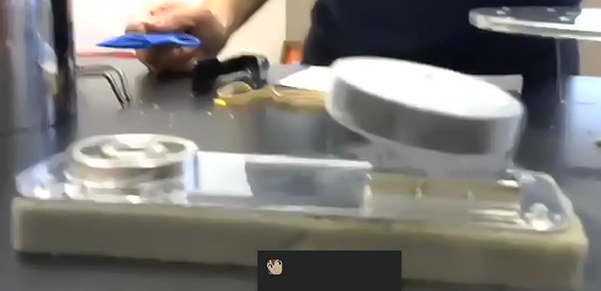
During Nadya Mason's presentation about the effect of temperature on materials, she demonstrates how a superconductor material which she had immersed in liquid nitrogen can "levitate."
What does art have to do with science? And vice versa? Some might opine, “Absolutely nothing!” However, those who orchestrated and taught I-MRSEC’s spring 2021 Musical Magnetism curriculum to Franklin STEAM Academy’s seventh and eighth graders would beg to differ. They suggest that art—including music videos, haiku, glass sculptures—even tap dance—can be used to communicate about science. Thus, as part of the program, several Materials Science experts shared about their favorite science topics, with some addressing how specific arts might be used to express them. By the program’s end, students had not only learned about science—they’d even tried their hand at describing the science they’d experienced via various art forms.

Andrea Perry shows Franklin students how to take apart the magnetic drawing board they received in their kit.
As part of the curriculum, three times a week for five weeks from February 2nd through March 4th, 2021, a number of I-MRSEC staff and researchers gave Zoom science presentations to Ashley Franklin’s and Jake Henss’ seventh grade classrooms, as well as Katie Lessaris’ eighth graders. Sessions addressed various topics related to materials—magnetism, atoms/electrons, the study of materials using virtual reality or microscopy, black holes, archaeology, even glass. Students received a packet of supplies in order to complete any hands-on activities instructors introduced related to their lessons. In addition to presenting about science topics, some presenters also suggested various art forms that might be used to interpret or communicate about their science. Students were then given several days to complete their projects in preparation for a final day of presentations on March 24th, showcasing the students’ artistic creations.
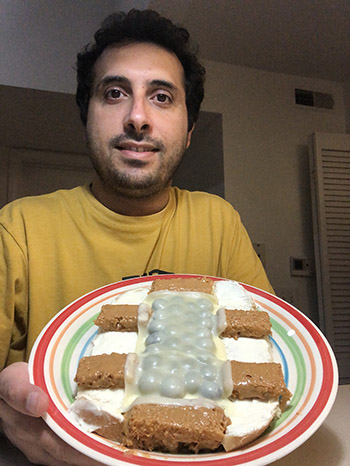
Onur Tosun shows "art" he made during I-MRSEC's "Bake Your Research Contest" in fall 2020.
A wide range of science topics and art forms were addressed. During the first week, on February 2nd, I-MRSEC’s Outreach Coordinator, Pamela Pena Martin introduced Musical Magnetism. She shared with students about its goals: that they were to learn about materials science from guest scientists, discover ways to creatively express science concepts, then, finally, each would create an artistic piece of their own to share with the class. After introducing scientists who would be participating and areas of science students would be learning about, Pena Martin touched on the types of artistic expression they’d hear about (music videos, dance, haiku, even glass blowing).
The following day, Pena Martin introduced students to materials science by discussing everyday objects and having students enumerate the various types of materials around them. She then disclosed that materials’ properties are determined by the atoms they’re made of and the way they’re arranged. Students then retrieved disk magnets from their kits and, after a discussion about magnetism, did activities demonstrating what magnetic forces are like.
Leading students in an exploration of Science Music Videos on February 4th was Physics’ Secondary Education Partnership Coordinator, Maggie Mahmood, who showed clips of science music videos she’s worked on, then shared how they can be used to express science concepts. After giving a brief overview of how music videos are made, Mahmood then familiarized students with Tik Tok, which they could use to create a science music video as their form of artistic expression.
During the second week, on February 9th, Physics postdoc Onur Tosun presented about static electricity in materials. After touching on his journey in science, he shared that the atoms materials are made of have electrons—and that some allow electricity to flow through easily while others don’t, also Informing students that materials with like charges repel, while opposite charges attract.
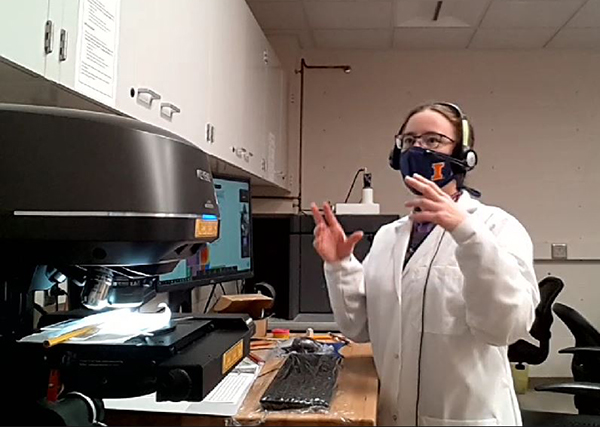
MRL staff scientist Kathy Walsh teaches a lesson about a 3D optical profiler.
Next, he did several demos with balloons, encouraging students to use the balloons from their kits. First, he charged two balloons, so students could see how they push away from each other; he charged a balloon and showed it deflect a stream of water; he also deflected a hanging straw using a charged balloon. Tosun also shared about his experiences using art to express science—painting and using food as art during I-MRSEC’s recent Bake-Your-Research Contest.
Imparting about how scientists study materials, Materials Research Lab (MRL) staff scientist Kathy Walsh led a lesson from the basement of MRL on February 10th. She demonstrated a 3D optical profiler, a tool that uses light to make detailed pictures of a surface. After explaining how the profiler works using LIDAR topographic images of local terrain as an analogy, Walsh used the profiler to look at pencils with the class—both brand new pencils like the ones found in their kits, plus a bumpy pencil she’d found that had been run over in a parking lot. They looked at features, such as cracks in the paint and the difference in smoothness between the eraser and the wood, plus she made colorful images depicting the material’s height.
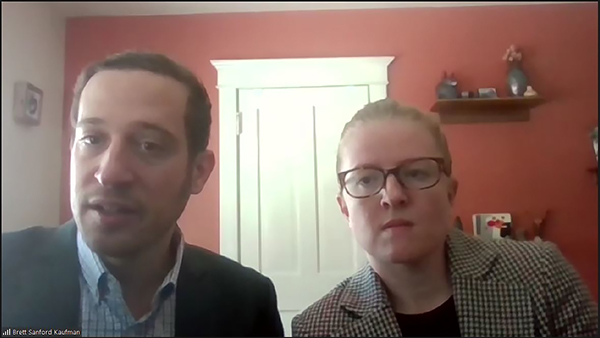
Archaeology professors Brett Kaufman and Kate Bishop share with Franklin students about their field.
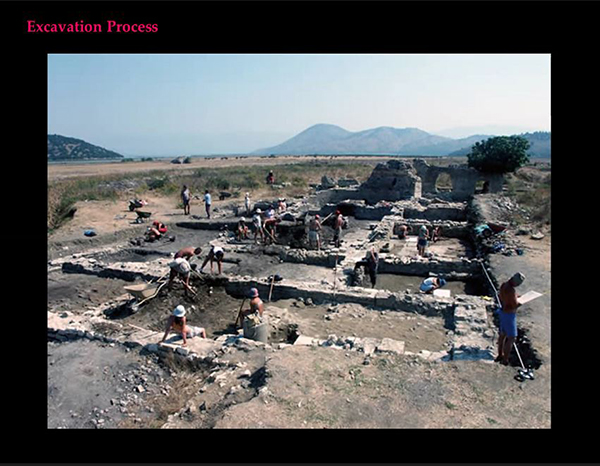
A slide Kaufman and Bisyop showed students illustrating what an archaelogical excavation site looks like.
The following day, Walsh led the students on a foray into writing science haiku. After introducing students to how scientists use color to highlight the features of a scientific sample, she had them create haikus about some of the science they’d experienced.
Talking about Archaeology on February 16th were two archaeologists: Professors Brett Kaufman and Kate Bishop. After sharing how they became archaeologists, the two explained what they do, the types of materials they study, and how these materials can tell us something about cultures around the world during different time periods.
Explaining how scientists study moving atoms in a material were Kevin Kleiner, a Physics grad student, who led the lesson, along with Haley Buckner, Kisung Kang, and Cindy Wong. First, Kleiner showed visualizations he’d created—what happens, including sound and vibrations, when atoms in a material move. Students were able to observe what happens to atoms when sound waves move in a material, then then separated into breakout rooms for more discussion about the phenomenon they’d observed.
Carmen Paquette, an I-MRSEC REU participant in summer 2019 who recently began her career as a materials scientist, was invited back to participate in Musical Magnetism due to her passion for expressing science via the arts—specifically, tap dance. So, on February 18th, the materials scientist/professional tap dancer shared how she combines her two passions—science and dance—through the use of dance to illustrate scientific concepts. After explaining how she uses body movement to exemplify the motion of atoms, she shared video clips of a dance she created to express her research, then answered students’ questions about her career path and dance.
On February 23rd, Materials Science Professor Andre Schleife, who studies materials using computers, presented the Virtual Reality of Materials. First, he discussed atoms and electrons in various materials, then used virtual reality to show different types of materials up close.
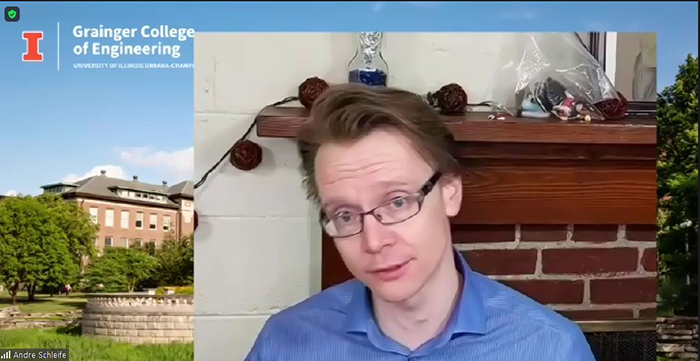
Materials Science Professor Andre Schleife presents the Virtual Reality of Materials to Franklin students via Zoom.
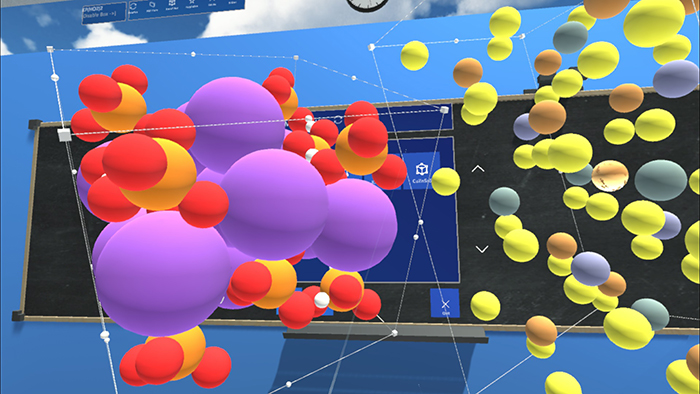
Schleife's slide showing students how VR can be used to study materials. For instance, in the above slide, the material with purple atoms on the left is monopotassium phosphate and is part of fertilizers, sports drinks, and used for optical applications; the material on the right, with yellow atoms, is Copper Zinc Tin Sulfide, which is used for solar cells.
“I wanted to show how virtual reality is a powerful tool to visualize complicated atomic and electronic structure of materials,” Schleife reports concerning his presentation. “By using VR, we can get an intuitive and comprehensive view of such details in a material, and we can interact naturally with those, e.g. by moving around, zooming, etc. VR creates an immersive experience that is hard to reproduce with other means.” Schleife also hoped to convey “that everything is made of atoms and electrons, and understanding what they do can help us predict/design novel materials.”
Schleife shares why programs that expose younger students to cutting-edge science are important to him. For example, he got involved in Musical Magnetism because he believes reaching out to students early on is key. In fact, that’s how he ended up in science himself. “It's important to get people excited about modern science and research!” he adds. “It's how we produce knowledge, and without that, we would not be able to make progress as a society.”
Passionate about recruiting students into Materials Science, Schleife ended with a spiel inviting students to consider it as a career. “Developing new materials to meet the demands of our modern society is an exciting endeavor,” he acknowledges, “and we are looking for students who want to participate.” Indicating that students with diverse interests like physics, chemistry, biology, math, computer and data science, even art/communication could find a niche in the broad field, he continues, “Everyone can participate, and the earlier you reach out, make contacts with the university, and network, the better. Having UIUC here in town is an excellent opportunity to do so, and I strongly encourage you to get in touch! Academics are friendly!"
(Plus, as a further incentive to pique students’ interest in materials research, Schleife reports that thanks to one of his students, Zhili Luo, a Materials VR app is available on his website and on the STEAM Store, too, as Materials VR.)
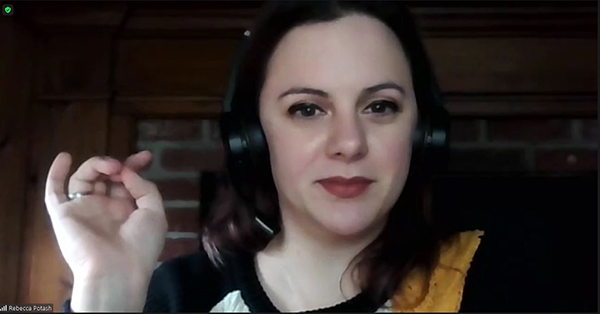
Rebecca Potash shares with Franklin students her presentation, Glass: Where Art, Science, and Fire Meet.
In her presentation, Glass: Where Art, Science, and Fire Meet, Rebecca Potash familiarized students with her work as both a scientist and a glass artist. Her February 24th presentation explained the history of glass (it’s been around since before 2000BCE), the science behind it, plus answered questions such as “Can glass be made in nature?” and “Why do old window panes have ripples?” She also showed students how artists make beautiful creations out of glass. (See the bottom of the article for one of her slides showing different creations made of glass.)
Also sharing that day was postdoc Kayla Nguyen, who shared a video produced by L’Oréal: The World Needs Women in Science: Meet the 2020 L'Oréal USA For Women in Science Fellows. She was featured in the video due to receiving L’Oréal’s 2020 For Women in Science Postdoctoral Fellowship. During the video, Nguyen gives girls interested in science some sage advice:
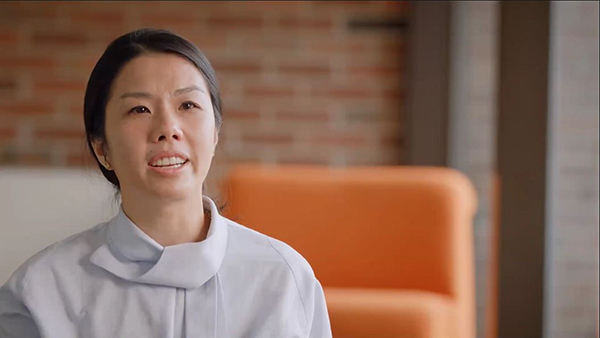
During a video produced by L’Oréal: The World Needs Women in Science: Meet the 2020 L'Oréal USA For Women in Science Fellows, Illinois postdoc Kayla Nguyen shares some challenges faced by women in science careers.
“Keep pushing. Don’t give up, even when it’s hard!” Indicating that she participates in STEM outreach activities in hopes of increasing the number of women in STEM, Nguyen explains: “I think the challenges that only women faced in STEM have been traditionally overlooked in many ways in comparison to the rigors of scientific research, whether it is related to gender-based discrimination, [such as] women are less intelligent or competent in math/physics, or social alienation from being the only woman in the room. It’s important that we promote women in STEM and their works in order to counter gender-based discrimination and to plug the leaky pipeline.”
On February 25th, Physics Professor and I-MRSEC PI Nadya Mason taught students about materials and temperature. Exploring the hypothesis, “When materials get cold, they slow down,” she demonstrated sticking various materials into liquid nitrogen to see what happens. (For instance, she stuck a rose in, which shattered afterwards.) The star of the show, though, was the Superconductor she immersed in liquid nitrogen, which, rather than shattering, levitated, moving around a circular track.
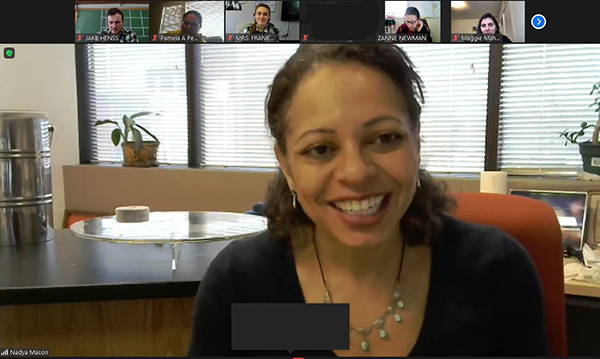
Nadya Mason enjoys her time sharing with Franklin students about the effect of temperature on materials. In the background, the superconductor material which she had immersed in liquid nitrogen spins around the surface of the plate.
Mason explains that her goal was “to show that material properties, from mechanics to electronics, are strongly affected by the temperature of the material. We chose to focus on temperature because it’s an easily-understandable parameter, yet it shows clearly how we can use different parameters to study and manipulate the properties of materials as part of materials research.”
Mason also shared some anecdotes with students regarding what it’s like to often be the only woman in a room full of scientists, and to be a woman of color in science. Her stories definitely impacted the kids, especially the girls. One said: “They better get used to us!” Another responded, “We are NEXT!!!!!”
Mason shares her philosophy behind Musical Magnetism, and why exposing younger, middle schoolers to cutting-edge science is important.
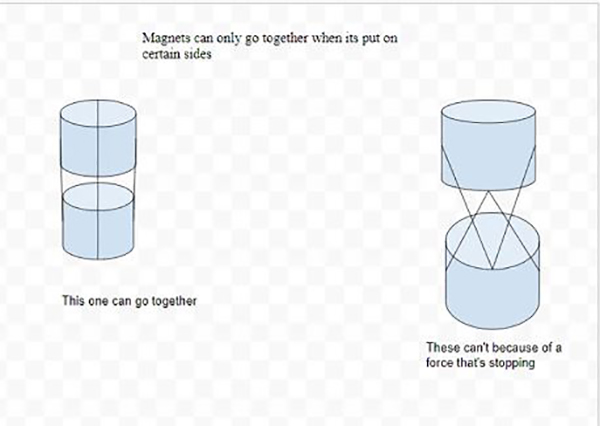
A graphic representaton of magnetism created by one of Franklin's seventh graders.
“The idea behind Musical Magnetism is to engage middle school students with science in a new way, through something particularly catchy to middle schoolers – i.e., music. We want middle schoolers to feel comfortable with science research topics, with hands-on experiments, with interacting with scientists, so that when it comes time for them to choose classes and majors, they feel like science – and especially materials research – is an exciting possibility for them.”
Of her section at the end, where she shared the challenges of being a woman of color in science. Mason shares some advice for young women of color, such as the students at Franklin, who might be interested in pursuing STEM: “I want students to know that there are fun and engaging careers paths in STEM. I especially want young women of color to know that they do belong.”
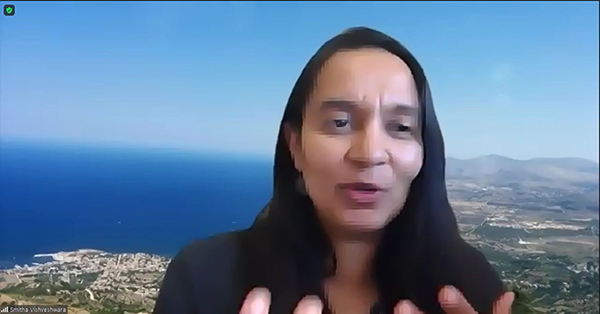
Physics Professor Smitha Vishveshwara shares with Franklin students about expressing science using art, especially performance art.
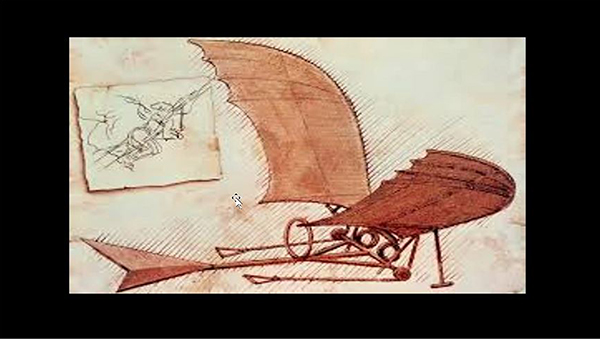
One slide Vishveshwara showed students was a drawing of a flying machine Leonardo Da Vinci desinged; DaVinci was both a scientists and an artist.
On March 2nd, Physics Professor Smitha Vishveshwara shared with students about creating art, including performance art, about science. Sharing that her father had passed on to her both his love of black holes and of expressing science via art, she is now passing on her passion for art and science with students at Franklin as well as in her PHY498 course: Where the Arts Meet Physics.
Physics Professor Gina Lorenz shared about materials and light on March 3rd, addressing the visible light spectrum, as well as ultraviolet and infrared light. Lorenz talked about how materials can respond to light, then led students in an activity using the UV beads from their kits to detect ultraviolet light.
March 4th was Destroy a Toy Day! Instructed by Pamela Pena Martin, Maggie Mahmood, Haley Buckner, and Andrea Perry, Franklin students took apart the magnetic drawing board they’d received in their kits to see how they work. Following a brief review of magnetism, students were asked to guess how the toys work, then adjourned into breakout groups where students got to explore, opening the drawing boards to see how they work and if they’d guessed correctly. Afterwards, they regrouped in the main room where volunteers shared what they’d learned.
In the final weeks of Musical Magnetism, students used an artistic form they’d chosen to express a science concepts they had learned about in the program. The week of March 9th–11th were student workdays. Students could draw something using paper and pencils supplied in the kits, write a haiku or other written word art, create a dance that illustrates a concept—some even chose to make a comic. Then on March 24th, they shared with their class by video or in class what they had created. Following are several haiku/poems shared by Franklin's students:
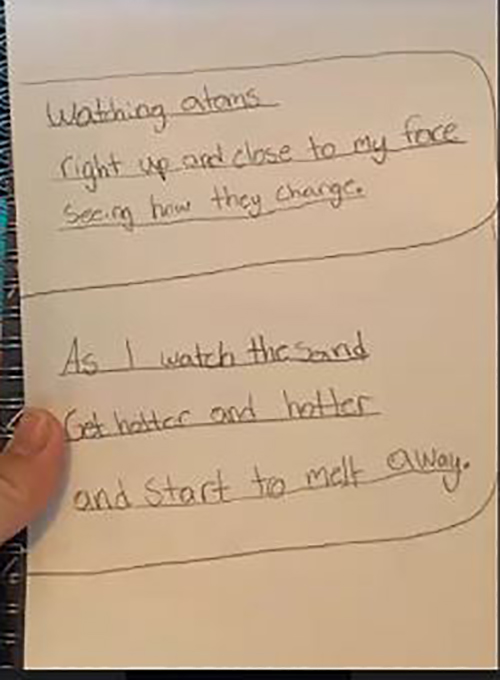
A haiku created by one of Franklin's seventh graders.
Atom Haiku
Atoms are so small
So very small particles
A piece of matter
My Haikus about this flex term
Science equals everything
Science equals cool
It shapes the world around us and make
The atoms create
A poem about science:
Science science science
Science is fun
Science is cool
Science is natural
And there’s so much molecules!
There’s so much to do
There’s so much to learn
There’s so many methods
There’s always more than one
Closely involved with the planning and implementation of the program was the school's Magnet Site Coordinator, Suzanne Newman, who explains why programs like Musical Magnetism are important for middle school students.
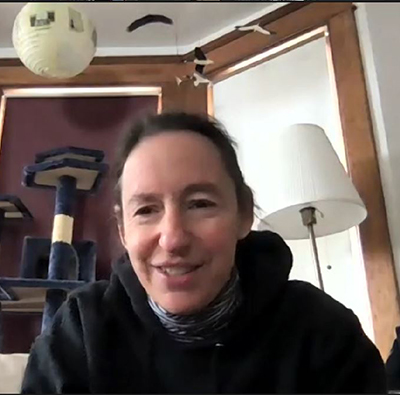
Suzanne Newman interacts with teachers during the Zoom session.
“This is the perfect age to let students see the paths of future study and possibly careers that are open to them,” she shares. “I think these various scientists help to show our students new ways of looking at the world.” Her hope is that the students might “start forming ideas about exciting futures that exist FOR THEM!”
According to Newman, her favorite activity of the program was watching Professor Mason chill a superconductor material then watching it travel around the track due to the magnetism. “Seemed more like magic than science!!” she acknowledges.
Concerning Musical Magnetism’s impact, Newman claims the program has been “SO impactful, since it opens so many doors for the students in terms of learning new and exciting things that they have never heard of! I see the students' questions in the chat when our guests come,” she reports, “and it makes me so excited to hear what they are learning and pondering. There is a world of exciting science that they are exposed to through this experience that is INVALUABLE!”
Story by Elizabeth Innes, Communications Specialist, I-STEM Education Initiative. Photos by Elizabeth Innes, unless noted otherwise.
For more I-STEM web articles about I-MRSEC's Musical Magnetism program, see:
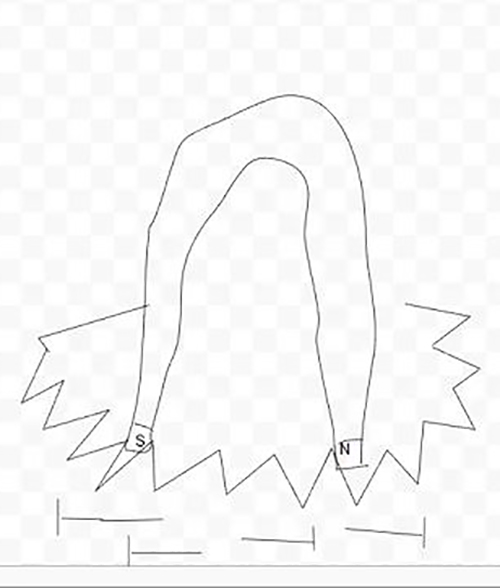
A drawing depicting magnetism created by one of Franklin's seventh graders.
- Paquette Conveys Her Love of Science, Dance to Franklin STEAM Students Via Musical Magnetism
- On Her First Foray into STEAM, Kathy Walsh Acquaints Franklin Students with Microscopy, Haiku
- Musical Magnetism’s Destroy-A-Toy Activity: Messy, Definitely Curiosity-Driven and Educational!
- Franklin Steam Academy Students Experience High-Tech Science at MRL
- I-MRSEC, Champaign Educator Jamie Roundtree, Embrace Hip Hop/Rap to Reach Youth at Their Level
More: 6-8 Outreach, Franklin STEAM Academy, I-MRSEC, STEAM/SciArt, Underserved, 2021
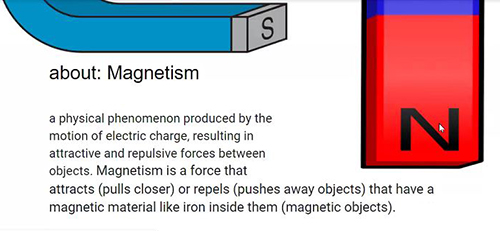 One Franklin seventh grader's art project about magnetism.
One Franklin seventh grader's art project about magnetism.
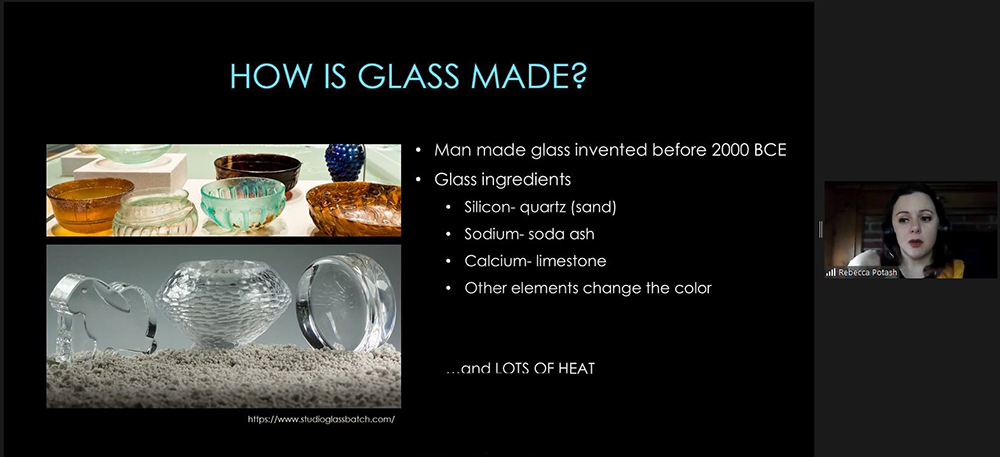 Rebecca Potash presents: Glass: Where Art, Science, and Fire Meet, sharing with students about her work as both a scientist and a glass artist.
Rebecca Potash presents: Glass: Where Art, Science, and Fire Meet, sharing with students about her work as both a scientist and a glass artist.












.jpg)















